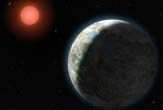Earth-Sized Alien Planets May Be Common, Study Suggests

There may be a bonanza of Earth-size alien worlds in the universe, scientists now suggest — nearly 1-in-4 of all sun-like stars might have a planet roughly the size of Earth orbiting close around them.
The new study found that there may be no shortage of planets with masses ranging from five to 30 times that of Earth, conflicting with previous planet models, researchers said. The findings also suggest that solar systems with Earth-size planets like our own may be common, they added.
The scientists focused on 33 known alien planets orbiting around 22 of the stars, some of which had been first discovered by the researchers themselves. Another 12 exoplanets were detected, but have not yet been confirmed. [Gallery: The Strangest Alien Planets]
Astronomers studied sun-like class G and K stars within 80 light-years of Earth with the powerful Keck telescopes in Hawaii for five years. Our sun is the best known of the yellow G stars, while K-type dwarfs are slightly smaller, orange-red stars. In all, they analyzed 166 of these stars, split roughly equally between G and K.
Alien planet-palooza
The researchers looked for any minute wobbles in each star potentially caused by planets between three and 1,000 times the size of Earth orbiting closely around them — just a one-fourth the distance between Earth and the sun.
The scientists estimate that about 1.6 percent of the sun-like stars in the sample had Jupiter-size planets, while 12 percent had super-Earths three to 10 times Earth's mass, the smallest currently detectable. This revealed a trend of increasing numbers of smaller planets, suggesting that planets the size of Neptune and smaller are probably much more common than giants such as Jupiter.
Sign up for the Live Science daily newsletter now
Get the world’s most fascinating discoveries delivered straight to your inbox.
To extrapolate further, "of about 100 typical sun-like stars, one or two have planets the size of Jupiter, roughly six have a planet the size of Neptune, and about 12 have super-Earths between three and 10 Earth masses," researcher Andrew Howard, an astronomer at the University of California at Berkeley, said in a statement. "If we extrapolate down to Earth-size planets between one-half and two times the mass of Earth, we predict that you'd find about 23 for every 100 stars."
While the researchers spotted an additional 12 possible planets in the new study, they have not been confirmed, said researcher Geoffrey Marcy, an astronomer at the University of California at Berkeley.
If those were included in the count, the team detected a total of 45 planets around 32 stars.
"As NASA develops new techniques over the next decade to find truly Earth-size planets, it won't have to look too far," Howard said.
Howard, Marcy and their colleagues detailed their findings in the Oct. 29 issue of the journal Science.
Bucking the planet formation trend
The new findings conflict with current models of planet formation and migration.
"These results will transform astronomers' views of how planets form," Marcy said.
After planets form a protoplanetary disk, researchers had thought only giant planets spiraled inward. Instead, where current models predict no small planets, the researchers found a surplus.
"I don't know for sure what's missing from the models, but I have a few guesses," Howard told SPACE.com. "One guess is that the disks of gas that planets are thought to migrate within during the birth of solar systems are more complicated than the models allow for. Another guess is that many small planets in a solar system may undergo a phase of scattering off of each other after the gas clears, a sort-of planetary billiard balls."
Based on these statistics, the researchers suggest NASA’s Kepler mission to survey 156,000 faint stars for planets will detect 120 to 260 "plausibly terrestrial worlds" orbiting near some 10,000 nearby G and K dwarf stars.
"This is a first estimate, and the real number could be 1-in-8 instead of 1-in-4," Howard said. "But it's not 1-in-100, which is glorious news."
What are these planets made of?
The researchers hope to learn much more about extrasolar planets by combining the results of their study with forthcoming data from NASA's planet-hunting Kepler spacecraft. While their study can detect planetary masses, Kepler can measure planet size with exquisite sensitivity.
Since the astronomers only detected planets very near their stars, there could be even more Earth-size worlds at greater distances, including within the habitable zone located at about the same distance as our planet is from our sun.
The habitable or "Goldilocks" zone is the distance from a star neither too hot nor too cold to allow liquid water to be present on the surface.
"By combining the planet masses with planet sizes, we're going to get a sense of the typical planetary densities and we'll be able to figure out whether these small planets we're finding are made mostly of iron, rock, water or gas," Howard said in an interview.












